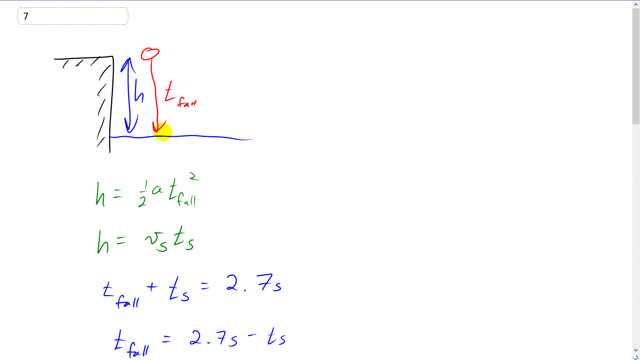
A stone is dropped from the top of a cliff. The splash it makes when striking the water below is heard 2.7 s later. How high is the cliff?

In order to watch this solution you need to have a subscription.
This is Giancoli Answers with Mr. Dychko. The rock will freefall from the top of the cliff down to the water, and that takes some time, let's say t subscript fall. And then after the rock hits the water, it creates a splash sound, and that sound goes back up to the top of the cliff where the person hears it and the sound takes some time, t subscript s for sound, to get there, from the water to the top of the cliff. And the total time that elapses between when the rock is dropped and the sound is heard is t fall plus t sound. Now, this height of the cliff can be expressed using either of these times. And we can say the height is 1/2 times the acceleration of this rock times the time it takes to fall squared. Or the height can be thought of as the speed of sound multiplied by the time that the sound spends traveling from the water to the top of the cliff. And we don't know either of these times but we do know the total is 2.7 seconds. And we can rewrite 1 of them. Let's say t fall as 2.7 seconds minus ts. And then substitute for t fall in this equation and say that this equals this because they're both equal to the height. And so we have 1/2 times acceleration due to gravity times 2.7 minus ts which is t times taking to fall squared equals the speed of sound multiplied by the time it takes to sound to travel from the water to the top of a cliff. And now it's a mathematics problem where we have to square this bracket and we end up with a quadratic equation and so on. So, we're solving for the time it takes for sound to travel from the water to the top of the cliff. And then we'll multiply it by that time by the speed of sound and get the height, 33 meters. So, the details are, you square this bracket. So, that's 2.7 squared which is 7.29 minus 2 times this times this which is going to be 5.4 times time for ts time sound plus times sound squared. And that equals vs ts. This brackets gets multiplied by 1/2 a. And then distribute the 1/2 a into the bracket there. And so we have 1/2 a times ts squared minus 1/2 a times 5.40 ts and then 1/2 a times 7.29. And then bring this to the left hand side. So, minus Vs ts and then equal 0. This is now the regular, the form that we have for a quadratic equation. And we can use a quadratic formula to solve it. And substituting for a and 9.8. So, we have 9.8 over 2 which is 4.9 and 9.8 times 5.4 over 2 makes 369.46. And also I put a plus 343 here because I collected the two ts terms, two linear terms, the two terms that have the unknownvariable to the power of 1. That's why they're called linear as a power of 1. Anyway. So, they're both minus. So, we can factor out the negative. And so we have a negative outside the brackets and then a plus inside. And so 5.4 times 9.8 over 2 plus 343 makes 369.46 times ts plus 305.721 equals 0. And then the quadratic formula comes to our rescue. And we have... That's, you know, negative b plus or minus square root of b squared minus 4 ac over 2 a, where you have a, time's the unknown squared plus b times the unknown plus c equals 0. And this coefficient of a linear term gets the opposite sign put here. So, 369.46 positive plus or minus 369.46 squared, you could say negative there, I guess, but it doesn't matter since its squared anyway, so it'll be always positive. Minus 4 times 4.9 times 35.721, all over 2 times 4.9. And that gives two answers. And on the calculator it looks like this, where I have the plus version shown here and the version to get this 0.0968086 is just the same with a minus there instead. So, those are the 2 solutions to this quadratic equation. And the only one that makes sense is this one, this 705 seconds is longer than a total time it takes for the rock or for the sound to, you know, for the rock to hit the water and for the sound to go back. It exceeds 2.7 in other words, so that makes it nonsensical. So, we'll just take this as our answer. And so our height will be the speed of sound, 343 times at 0.0968086 seconds which gives us an answer of 33 meters for the height of the cliff.